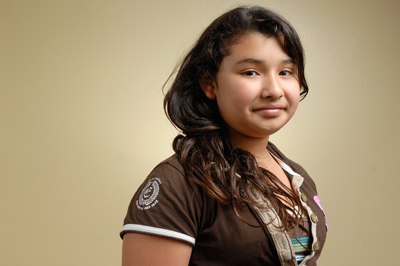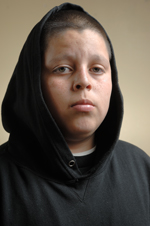 About a year ago, I photographed competing immigration rallies in San Rafael. On one side of the street were advocates for the local Latino community; on the other were members and supporters of the Minutemen, a conservative anti-immigrant organization. Both groups were a rarity in Marin County, an affluent, mostly white, heavily liberal enclave just north of San Francisco.
About a year ago, I photographed competing immigration rallies in San Rafael. On one side of the street were advocates for the local Latino community; on the other were members and supporters of the Minutemen, a conservative anti-immigrant organization. Both groups were a rarity in Marin County, an affluent, mostly white, heavily liberal enclave just north of San Francisco.
A few weeks earlier, federal immigration agents had raided homes and businesses in the city’s Canal neighborhood, a tightly packed area of run-down apartment buildings and small homes that is home to 12,000 people, 86 percent of them immigrants from
The raids were part of the broader immigration debate in the country, a divide that had spawned huge marches across the country. I wanted to put something together for Marin magazine about how the issue played out in suburbs, but was hesitant for a couple of reasons. First, I was jammed with doing the book. Second, after 20 years of traditioal journalism I didn’t want to write an on-the-one-hand-but-on-the-other type story where the emotion got buried under a slag heap of official statements from either side.
After I finished the book this spring, I began talking with Tom Wilson, head of the Canal Alliance, the Canal neighborhood’s primary social service group, about different story ideas. He pointed me to an after-school program that tutors neighborhood children, teaches them other academic skills and exposes them to a world of possibilities outside the Canal. The program guarantees that if a child sticks with it, he or she will graduate from high school and enter a community college.
I told Tom I’d like to photograph the kids in the middle-school program and ask them a few questions about their dreams. Then I pitched the idea to the magazine, adding that I’d write an introductory essay — not a story — about the immigration issue. To my surprise, they loved the idea.
 I made the photographs over three afternoons in a classroom. I wanted the pictures to be simple portraits, so I posed the children in the middle of the room and lit them with one umbrella and a big reflector, using the far wall for a backdrop. I spoke with each for about five minutes first, talking about their dreams, their families and their countries of origin. Most of the interviews were in English, a few were in Spanish.
I made the photographs over three afternoons in a classroom. I wanted the pictures to be simple portraits, so I posed the children in the middle of the room and lit them with one umbrella and a big reflector, using the far wall for a backdrop. I spoke with each for about five minutes first, talking about their dreams, their families and their countries of origin. Most of the interviews were in English, a few were in Spanish.
Some of the children dreamed big — to be doctors or lawyers. Others wished for little more than a visit home to their family in Mexico. Some rushed forward to be photographed. Others I had to persuade through cajoling.
If you look at the photographs, you will see the faces of children, but also, in many of them, the eyes of adults who have seen more of the world, a rough world, than any 12- or 13-year-old should.
If you read the essay (below), you will learn how I feel about this children, which is that regardless of how any of us feels about immigration the children of immigrants should not pay the price. Who are we to deny them better lives — especially in the United States, a country founded on that very principle?
* Here are the photographs.
* Here is a PDF of the Marin Magazine package, including the essay.
* Or, click the jump for the essay.
————————————————————————
Sueños de Niños
Are we paying for the immigration debate with the dreams of children?
By Tim Porter
“I just want my family to have a better life than I did – to live in a house, to have money to buy things, to never feel like we didn’t have enough to eat.”
— Ivan, 14,
It’s election season and that means a monstrous mass of warm political air is forming over the country. Much of the rhetoric will be devoted to immigration, a frothy social stew as complex as any on the national menu, but one nonetheless that politicians and pundits will boil down to bite-sized chunks of overcooked language designed for quick partisan digestion.
Illegal immigrants. Undocumented workers. Amnesty. Earned legalization. Each side frames the debate in words intended to play on the xenophobia or compassion of voters. The process is manipulative, to say the least. Beyond all the politicking and policy-making, though, immigration is about people – as it has been in the
Through the centuries, immigration policy has swayed to the tune of the times. Immigrants were welcomed or rejected depending on national economic need or the fickle direction of political winds. When we needed cheap labor to build the Western railroads, for instance, we imported it from
Each set of succeeding arrivals were relegated to the bottom rung of the socio-economic ladder, where they suffered various forms of discrimination, subtle and overt. At varying points in U.S. history, the national immigration debate (and social scorn) centered on people whose names began with “Mc,” ended with “witz” or had too many vowels.
Today, as the long march of the presidential campaigns slogs toward November, the phrase “immigration debate” is synonymous with names that end in “ez” – Sanchez, Rodriguez, Fernandez.
This group, Hispanics, is the nation’s largest minority – more than 44 million people, an estimated 11 million of whom emigrated through the back door, either via a dangerous border crossing or an overstayed visa. Depending on your choice of language, they are either illegal or undocumented. Either way, they are sin papeles – without papers – and living in a netherworld in which hope for a better life is every day diminished by fear of deportation.
Although nearly a third of the nation’s Hispanics live in California, affluent and mostly white Marin County is home to relatively few – and most of them live in the Canal neighborhood of San Rafael, where the old Anglo street names of Larkspur, Belvedere and Vivian seem culturally anachronistic in a community in which Spanish is not just a first language but in many households the only one.
The Canal is home to 12,000 people packed into 1.2 square miles, 86 percent of them immigrants from
The future of that debate, though, is not found on a street corner but in the classroom.
These students live amid the uncertainty and tension of the immigration tug-of-war. Even for those who are documented or citizens, the anxiety hovers. Families are separated, friends are deported, fairer-skinned strangers judge with a harsh look and an unspoken message no child should hear: You are a burden and a blight.
Yet, children they are and like children everywhere they dream. Some of their dreams reflect the hardness of living on the economic edge (“I would like to help people. I feel bad for the little kids that don’t have homes,” says a 12-year-old whose family is from
The Canal Alliance, the neighborhood’s primary social service organization, helps students stay on the educational path that can turn dreams into reality. Its Youth Education and Development Program tutors, counsels and provides other academic services for 150 students a year and guarantees that any student who stays with the program will make it out of high school and enroll in college – quite an accomplishment for a child who must learn a new language, get the right grades, and overcome the financial hardships common in a community where the median family income is about $36,000, less than half that of the county as a whole.
The young people whose photographs you see here are part of the Canal Alliance program. They are smart, eager to learn, and, sadly, more streetwise than you’d expect a
In the name of politics, though, that’s what happens. In most
National legislation called the Dream Act would undo this system by allowing illegal immigrants who met certain conditions (longevity in community, among them) the right to gain legal status and receive the same educational benefits as any other student, including financial aid. Introduced in 2001, the bill has languished in Congress.
Ten states, however, including
